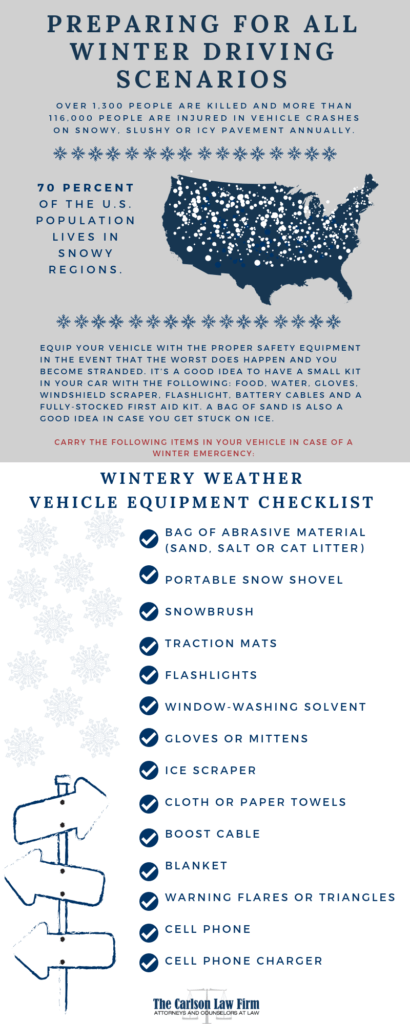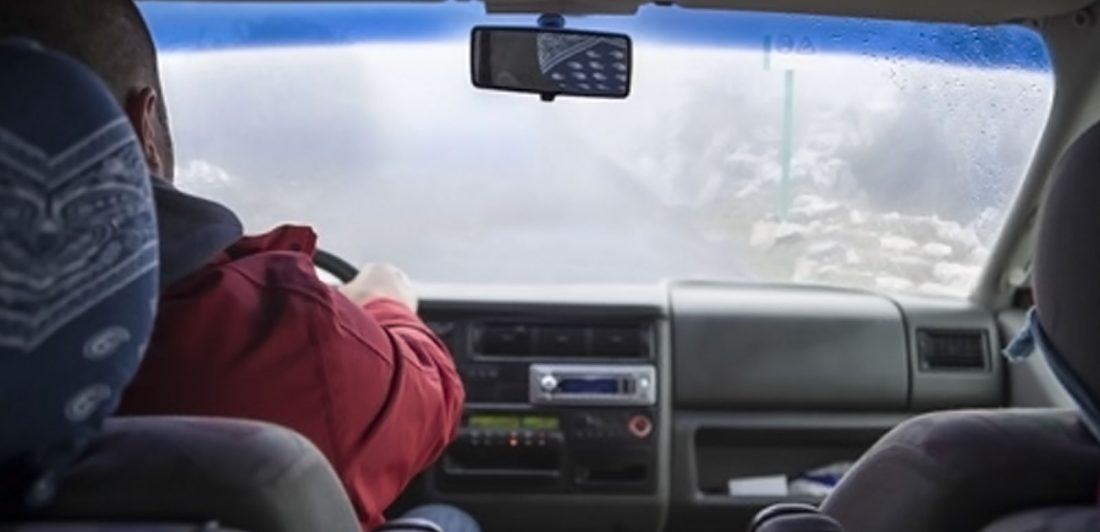As we move deeper into December, temperatures are dropping across the nation and the chances of inclement weather are increasing. With these weather changes comes a shift in the road conditions—just in time for the drive home to visit your family for Christmas. Driving with your family in tow, and probably carrying more weight than usual with added luggage, means taking extra precautions for winter driving.
Weather can become very severe throughout the state, so it is important to drive with extra care.
According to the Federal Highway Administration, more than 70 percent of the nation’s roads are located in snowy regions. A snowy region is defined as one that receives more than 5 inches of snowfall annually.
Common Types of Winter Weather Car Crashes
The best way to avoid a crash is to be aware of how you are driving and aware of your surroundings. While certain driving risks exist year-round, winter driving comes with its own unique set of risks. Heavy snowfall and slick roads can lead to serious accidents—even for the best drivers. The following are the most common types of winter weather car crashes:
Sliding
Snow, ice, sleet and rain create less than ideal road conditions. As a result, one of the most common causes of winter weather car crashes is caused by sliding on slippery roads. Unfortunately, sliding can lead to various types of collisions.
Rear-Ends
Driving too quickly or too close to the car ahead of you in bad weather can lead to rear-end collisions. Winter weather often requires frequent stops. It is important to be a courteous driver and be mindful of your speed.
Spinning Out
Wintery weather on the roads puts vehicles at risk for spinning out of control when driving in snow and ice conditions. You can avoid accidents by driving slower and not over-correcting when you lose control of the vehicle.
Left-of-Center Collisions
Because of snow-covered roads, or in some cases sliding, drivers may find it difficult to maintain their lane leading to left-of-center crashes. These crashes are common on crowded roads. Avoid these types of accidents by slowing down and staying aware of your surroundings. However, if you find yourself drifting, attempt to regain control without hitting the brakes.
What Negligent Actions Can Lead to Winter Weather Car Accidents?
There are a variety of conditions that can lead to a dangerous situation. In fact, snow and icy road conditions lead to more than 1,300 deaths and over 116,800 injuries each year. Because winter weather road conditions already make for dangerous situations, avoid these actions:
Unnecessary Travel
Drivers who don’t have to go out shouldn’t. Keep an eye on the weather and make sure to plan your trip to the grocery store ahead. Further, if the weather conditions are bad enough, consider skipping or rescheduling minor or unimportant trips.
Driving Too Fast for Weather Conditions
Speeding, even in perfect weather, is always dangerous. But when the weather affects road conditions, drivers need to slow down. Snow, ice, sleet, and rain make the roadways slick in addition to reducing visibility. In more severe conditions, it may be necessary to drive below the posted speed limit. In fact, the Federal Highway Administration recommends that drivers reduce their speed by 30 to 40 percent in bad weather on city streets. Aditionally, when traveling on freeways, drivers should reduce their speed by 3 to 13 percent and 5 to 40 percent during heavy snow.
Quick Acceleration
Accelerating too quickly prevents the tires from gaining traction, which could cause the vehicle to skid, slide, or spin out of control. Slow, steady acceleration will help the tires gain traction on icy or snowy roads and keep the vehicle in control of the driver.
Driving with Reduced Visibility
Drivers who fail to remove ice and snow from their vehicle’s windows before driving are putting others at risk. When this occurs, visibility while driving is significantly reduced. Before driving, drivers need to slow down and clear their vehicle’s windows of ice and snow. Additionally, using the vehicle’s defroster will keep windows and, most importantly, the windshield clear while driving.
Tailgating
Icy or snowy roads mean that vehicles need more space to come to a complete stop. A negligent driver may be in a rush to get to their destination. As a result, they may resort to tailgating or following too closely. Drivers should leave for their destination in enough time to drive responsibly in winter weather.
Under normal conditions, AAA recommends driving three to four seconds behind the car ahead. However, in poor weather conditions, it says that the following distance should be increased to eight to ten seconds.
Braking Too Late
Vehicles require more time to stop on slick roads. Drivers should allow extra time for stopping their vehicle. In addition, drivers should avoid driving cars they are unfamiliar with in bad weather. Being familiar with how the vehicle brakes can help drivers prepare to properly apply the brakes in unexpected situations.
Vehicles with anti-lock brake systems may require drivers to press the brakes harder to achieve a quicker stop. Having this level of knowledge and comfort with your vehicle can prevent a serious crash.
Prepare Your Vehicle for Winter Driving
It is very important to start preparing for winter driving even before you start the car for your trip. Before severe weather hits, make sure your vehicle is well-maintained. This is, of course, best done by a professional mechanic.

Electrical System
Ensure that your vehicle’s battery is in tip-top shape. During the colder months, your battery needs to be fully charged to start your vehicle. If your battery is older than three years, have your battery checked and replaced. In addition, you should have your alternator or generator, voltage regulator, and drive belts checked too.
Your ignition system should be checked as well. Damaged ignition wires, a cracked distributor cap, and worn spark plugs can make starting your vehicle difficult or lead to a breakdown. Avoid these issues by having your vehicle checked ahead of the cold weather.
Finally, bad weather can make it more difficult to see and be seen. Ensure your vehicle’s lights and lenses are functioning properly. Grime on headlights reduces their effectiveness by as much as 90 percent.
Brake System
The ability to slow your vehicle is necessary for driving in any driving environment. Have your brakes checked regularly and do not delay any necessary maintenance or repairs.
Tires
Tire traction determines how well your vehicles accelerates, turns, and stops on a road surface. Be sure to check the tread-depth of your tires using the penny test or a tire tread gauge. This is especially important if you live in an area that receives light to moderate snowfall. All-season tires are good for climates that receive this level of snowfall.
However, those who live in areas or traveling to areas with heavy snow might want to consider snow tires. Snow tires are specifically designed for driving in snowy weather or snow-covered roads. On some roads, you may be allowed to drive with chains on your tires. If you need chains on your tires, be sure to follow the posted signs.
Exhaust System
Keeping the windows up and running the heat to keep warm is a major bonus of living in the modern era. But before the snow starts, have a mechanic check your exhaust system for leaks. This will minimize your chances of carbon monoxide poisoning. The exhaust system carries away carbon monoxide and other harmful gases produced by your car’s engine. If you become stuck in the snow and have your engine running, open a window slightly and clear snow away from the exhaust pipe.
Windshield Wipers, Washer Fluid, Glass and Vehicle Exterior
During bad weather, your windows are your lifeline. Having clean windows is imperative for optimal visibility. Have your windshield wipers replaced periodically to avoid streaks on your window. In addition, your washer reservoir bottle should have an anti-freeze water solvent. Clean windshields of ice and snow to prevent damage to your wipers.
Gas Tank
Keep your gas tank half full at all times. This helps to keep moisture from collecting in the fuel lines, which can freeze. This is also a good idea because if you are stuck in bad weather on the side of the road, you will be able to run your car for heat.
The Carlson Law Firm Can Help
The Carlson Law Firm has years of experience protecting the rights of injured people all over the nation. We have a successful record of helping recover just compensation for those involved in car crashes. As your attorneys, we will use our specialized knowledge to fight for you to get you the compensation you deserve for your injuries.
We are available to speak with you 24/7. We care, and we can help.





